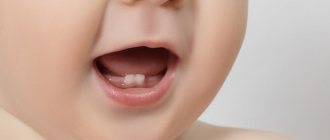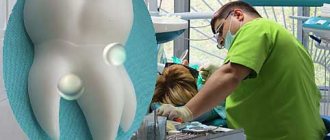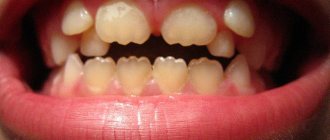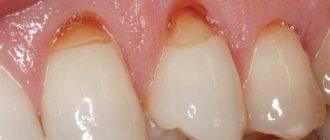What is Priestley plaque on teeth?
This is a dental problem that occurs in children. In this condition, deposits are found on the enamel of the teeth. Dark plaque on a child’s teeth can be black or brown, sometimes with a light or pearlescent tint. As a rule, it is located as a thin border along the lower edge of the teeth closer to the gums. But plaque can also cover a large area of the tooth or look like a small spot on the enamel. Most often, dark deposits appear on the inside of the teeth, less often in the interdental space or on the outer surface of the teeth.
Photo courtesy of InWhite Medical Clinic
Possible consequences after a bruise
It is no secret that any injury received can subsequently cause complications. A tooth bruise is no exception. Moreover, the consequences can appear even when appropriate treatment has been performed. This occurs if the pulp zone has been severely damaged.
The tissue will gradually begin to die and necrosis will appear. With necrosis, inflammation occurs, which must be addressed immediately. The earlier it is identified, the more successful the forecasts will be.
But the most common occurrence is staining. Parents notice that the child’s tooth has darkened after being hit. Darkening occurs quite quickly. This may be due to periodontal trauma, or may be a consequence of a lack of nutrients. They cannot supply what is needed because the dental tissues and fibers are damaged.
There are also more serious violations that occur over time. These include the formation of cysts in damaged areas.
In any of the above cases, adequate treatment often brings positive results.
How to detect dark plaque in time
- regularly examine the child’s oral cavity independently;
- do not postpone scheduled visits to the dentist.
It must be taken into account that Priestley plaque on the teeth often accumulates slowly, which is why the child gets used to the stains on the enamel and does not tell his parents about them. Darkening of teeth can occur quickly, literally overnight. Reactive appearance most often occurs during illness, accompanied by intoxication, dehydration and increased body temperature. This is due to the fact that the child’s body reacts sharply to various changes in diet, the functioning of internal organs and in external conditions.
Deposits most often occur at the age of 2-3 years. However, they can also appear on the very first milk teeth of a one-year-old child. Or it could affect the baby teeth of a younger teenager who haven’t had time to change. The darkening may also spread to permanent teeth.
Treatment methods
It should be noted that not in all cases, blackened milk teeth can be made milky white again.
If your child’s teeth have darkened as a result of plaque accumulation due to poor oral hygiene, a visit to the pediatric dentist will help deal with this problem. The specialist will perform an examination and conduct a thorough cleaning, removing dense deposits from baby teeth.
You can solve the problem of darkening of teeth caused by exposure to food pigments, even without the help of a specialist, using home remedies. You need to carefully brush your teeth and rinse your mouth several times. The result will be noticeable after the first thorough brushing of your teeth. If the plaque has turned black, the desired effect can only be achieved after professional cleaning by a specialist.
If caries is detected, the key task is to preserve the baby tooth, especially if it is not yet changing and the child is under six years old. The black color of teeth in the presence of this problem is caused by the accumulation of food residues, bacteria and necrotic masses. After removing the affected dental tissue, the specialist will fill the cavity. As a result, the original light color of the tooth will be restored. In extreme cases, if caries can no longer be cured, the tooth is removed.
If the blackness of the tooth is caused by trauma associated with damage to blood vessels and the formation of a hematoma, the specialist will analyze the existing treatment options, taking into account the symptoms of pulpitis (pain in the damaged area, increased body temperature, deterioration in the patient’s general well-being). If there are no symptoms of the inflammatory process, the child does not need specific therapy. But it will no longer be possible to restore the light color of the tooth.
Today, darkening of baby teeth as a result of improper use of medications is very rare. If your child has such a problem, it will not be possible to get rid of the blackness until the teeth change. In such situations, it is necessary to ensure the highest quality oral hygiene in order to prevent the process from worsening. If medications have affected permanent teeth, it is necessary to do whitening using professional methods. Sometimes prosthetics can also be used.
As in the previous case, it is not always possible to restore the color of tooth enamel when fluorosis develops. The main goal of therapy is to avoid the progression of pathology by minimizing the amount of fluoride consumed. This issue is especially relevant if the child’s age does not exceed 1 year, since fluorosis affects not only the teeth, but also the children’s skeletal system.
It is impossible to restore the color of enamel after the silvering procedure. In this regard, this procedure should not be carried out in preschool age. After its completion, an external defect appears, which can cause a negative reaction from other people.
Why does a child have black plaque on his teeth?
The main problem with the appearance of Priestley plaque on teeth is not that it causes bad breath, looks unsightly, or cannot be removed independently without the help of a hygienist. Priestley's plaque is a signal that something has changed in the child's body, due to which non-dangerous bacteria began to actively multiply, creating deposits. And for high-quality treatment and prevention of the development of diseases, it is necessary to find out why black plaque forms on the teeth, the reasons for the appearance of beneficial living conditions for bacteria.
Possible causes of plaque:
➢
diabetes;
➢
genetic feature or hereditary predisposition;
➢
thyroid diseases;
➢
incorrectly selected hygiene products;
➢
parasite infection.
Dysbacteriosis.
Disruption of the gastrointestinal tract can occur due to malnutrition, food poisoning, immaturity of the digestive system, taking antibiotics or chronic diseases of the stomach, liver, and intestines.
Caries.
Due to the fact that parents usually do not brush their baby’s first teeth, yellow plaque begins to accumulate on the enamel, which over time can cause caries. Irregular or insufficiently high-quality tooth brushing by the child himself also leads to the formation of caries. Carious lesions create a favorable environment for the growth of bacteria, which causes Priestley plaque to appear on baby teeth.
Dehydration.
Due to dehydration due to various reasons, the body cannot produce enough saliva to wash the teeth and remove food particles. Because of this, bacteria begin to multiply faster, and a dark plaque forms on the child’s teeth. Therefore, it is important to ensure that your baby gets enough fluids, especially in hot weather or during illness.
Hypoplasia of tooth enamel.
Some children have underdeveloped top layer of enamel. It is weakened and unable to perform a protective function.
Disorders of dental development in the prenatal period.
Dental buds may be damaged during development due to viral infections suffered by the mother, calcium deficiency, iron deficiency, or taking certain medications.
Improper functioning of the immune system.
Malfunctions in the immune system can affect the body's ability to suppress bacterial activity.
Malocclusion.
If a child has a malocclusion, the load on the jaw when chewing is distributed unevenly, which is why some of the teeth receive increased load, but are cleansed with solid food: carrots, apples. And unused teeth become covered with plaque.
Diagnosis of Priestley plaque on teeth
If darkening is detected on the enamel of a child’s teeth, you must contact a dental clinic.
The specialist will:
✔
inspection;
✔
laser diagnostics to determine the depth and size of the lesion;
✔
anamnesis collection.
After a conversation with the parent and child and collecting an anamnesis, the pediatric dentist will immediately prescribe treatment or conduct an additional examination. You should not neglect it - it is important for a specialist to find out why the child has black plaque on his teeth. Only after this will he be able to provide quality treatment.
Possible cause of tooth darkening
The most common reason that a child’s baby tooth has darkened is mechanical impact on it. A bruise can occur for a large number of reasons, which sometimes depend and sometimes do not depend on the child.
Children are considered the most common population group to experience tooth discoloration. This happens due to a mistake made by a parent, or due to a child’s inattention.
A tooth bruise is a mechanical injury caused by a hard object. In the case of which the tooth itself does not suffer, the main blow falls on the periodontium. It can lead to bleeding and severe tissue rupture.
With a strong blow, vessels can be damaged, damage to which leads to hemorrhage, and pulp tissues are affected. In this case, there is no need to panic; most of these symptoms are reversible if you consult a doctor immediately after the first sign of a bruise.
Many parents do not take this fact seriously, because baby teeth are a temporary phenomenon; permanent teeth will grow in their place. These are deeply erroneous thoughts; they, of course, will grow, but darkened baby teeth without appropriate treatment will negatively affect their structure.
Therefore, at the first suspicion of a bruise, even if no serious violations are observed with the naked eye, it is recommended to take the child to see a dentist.
Additional protective measures for Priestley's raid
It is possible that Priestley's plaque on the teeth appeared due to an infection and, as a result, a temporary deterioration in the functioning of the immune system. But it is necessary to make sure that there are no serious and dangerous deviations in the child’s health. Therefore, if dental plaque is detected, the dentist will recommend taking additional measures:
- get tested for the presence of parasites in the body;
- consult a gastroenterologist;
- take tests to check the level of iron and calcium in the body;
- check your blood sugar levels.
These measures will help identify the problems that are causing plaque to form on your teeth.
How to remove black plaque on teeth
It is impossible to remove dental plaque at home. Moreover, the use of abrasive agents and intense exposure to teeth with a brush can cause an increase in dental problems: thinning or damage to the enamel, trauma to the gums or mucous membrane.
Priestley's plaque on children's teeth can only be removed in a well-equipped dental clinic. The specialist will:
- professional teeth cleaning;
- If necessary, treat the teeth with a remineralizing composition.
If plaque formation is caused by dental problems, additional treatment may be prescribed, including bite correction.
The doctor will also select a home hygiene kit that is ideal for the child: a toothbrush of the correct shape and hardness, toothpaste with the optimal composition, and mouth rinse. Additionally, the hygienist will teach the child how to brush their teeth correctly and will talk about the need for quality oral care.
Taking into account the causes of the disease, the dentist may prescribe additional treatment measures, for example, recommend dietary supplements, dietary nutrition, avoidance of drinks and foods with dyes that affect the color of the enamel.
Preventive measures
You can avoid darkening of teeth in childhood without much hassle. Parents are advised to remember the basic rules, which are very important to adhere to:
- Pay sufficient attention to regular checks of the quality of the child’s oral hygiene. It is better to teach children the need to brush their teeth after the first tooth appears (even before the age of 12 months). Thanks to the formation of this habit from the first years of life, it will be possible to maintain the beautiful color of the teeth and the health of the child in general.
- A thoughtful diet is very important to prevent the darkening of children's teeth. Consuming sufficient amounts of key nutrients, minerals and vitamins significantly reduces the likelihood of developing dental problems. To avoid the appearance of black teeth in baby teeth, parents should control the amount of sweet carbonated drinks, confectionery and white pastries in the child’s diet. At the same time, it is very important that children consume raw vegetables and fruits, as well as dairy products.
- It is important to select the appropriate teeth cleaning products. For example, one-year-old children need a completely different toothpaste compared to schoolchildren. It is important to regularly replace toothbrushes, the choice of which also depends on age.
- In areas where drinking water contains high amounts of fluoride, it is important to control its quality. This is a very important moment for children in the first year of life, because it is at this time that bones and teeth are formed.
- Regular visits to a specialist for preventive examination, therapy and cleaning are factors that prevent the darkening of baby teeth.
- To prevent caries or treat a minor problem of this type, it is better to use deep fluoridation instead of silvering. The procedure prevents the development of dark plaque and is more effective.
All experts say that preventing problems with baby teeth is easier than treating them. Regular preventative measures minimize the likelihood that your child's teeth will begin to turn black or fall out before permanent teeth emerge.











